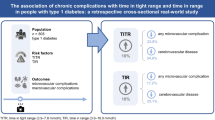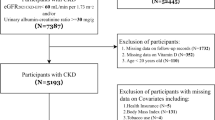Abstract
Background
Diabetic kidney disease (DKD) is the leading cause of end-stage renal disease (ESRD) in Japan. The clinical course and factors related to the progression of DKD to ESRD are important issues when treating patients with DKD.
Methods
Ninety-one type 2 diabetic patients with DKD that had progressed from chronic kidney disease (CKD) stages G1–3 on their initial clinical visit to ESRD were enrolled. The decline in the estimated glomerular filtration rate (eGFR) was analyzed and the initial clinical factors that influenced the decline rate were explored.
Results
There was a linear decline in eGFR before progression to ESRD, with a median annual decline rate (∆eGFR) of 9.2 mL/min/1.73 m2. In all patients, a history of coronary artery disease and increased levels of initial eGFR and high-density lipoprotein cholesterol (HDL-C) were positive predictors of log ∆eGFR, whereas age, history of cerebral infarction (CI), and an increased level of serum albumin were negative predictors of log ∆eGFR. In patients with CKD stages G1–2 on their first visit, male sex and increased diastolic blood pressure were positive predictors. In patients with CKD stage G3 on their first visit, an increased level of LDL-C was a positive predictor, whereas a history of CI and an increased level of serum total bilirubin (TBil) were negative predictors.
Conclusion
In addition to the common risk factors, initial eGFR, HDL-C, and TBil were identified as novel risk factors for ESRD. These risk factors may differ between patients with early and advanced stages of CKD.


Similar content being viewed by others
References
Nakai S, Watanabe Y, Masakane I, Wada A, Shoji T, Hasegawa T, et al. Overview of regular dialysis treatment in Japan (as of 31 December 2011). Ther Apher Dial. 2013;17:567–611.
Molitch M, DeFronzo R, Franz M, Keane W, Mogensen CE, Parving HH, et al. Nephropathy in diabetes. Diabetes Care. 2004;27:S579–83.
Skupien J, Warram JH, Smiles AM, Niewczas MA, Gohda T, Pezzolesi MG, et al. The early decline in renal function in patients with type 1 diabetes and proteinuria predicts the risk of end-stage renal disease. Kidney Int. 2012;82:589–97.
Krolewski AS, Niewczas MA, Skupien J, Gohda T, Smiles A, Eckfeldt JH, et al. Early progressive renal decline precedes the onset of microalbuminuria and its progression to macroalbuminuria. Diabetes Care. 2014;37:226–34.
Krolewski AS. Progressive renal decline: the new paradigm of diabetic nephropathy in type 1 diabetes. Diabetes Care. 2015;38:954–62.
KDIGO. Clinical practice guideline for the evaluation and management of chronic kidney disease. Kidney Int. 2012;2013:3.
Sheen Y-J, Sheu WH. Risks of rapid decline renal function in patients with type 2 diabetes. World J. Diabetes. 2014;5:835–46.
The National Kidney Foundation. KDOQI clinical practice guideline for diabetes and CKD: 2012 update. Am J Kidney Dis. 2012;60:850–86.
Matsuo S, Imai E, Horio M, Yasuda Y, Tomita K, Nitta K, et al. Revised equations for estimated GFR from serum creatinine in Japan. Am J Kidney Dis. 2009;53:982–92.
Fukuda M. Classification and treatment of diabetic retinopathy. Diabetes Res Clin Pract. 1994;24:S171–6.
Shimamoto K, Ando K, Fujita T, Hasebe N, Higaki J, Horiuchi M, Imai Y, Imaizumi T, Ishimitsu T, Ito M, Ito S. The Japanese Society of Hypertension guidelines for the management of hypertension. Hypertens Res. 2014;37:253.
Björck S, Mulec H, Johnsen SA, Nordén G, Aurell M. Renal protective effect of enalapril in diabetic nephropathy. BMJ. 1992;304:339–43.
Hillege HL, van Gilst WH, van Veldhuisen DJ, Navis G, Grobbee DE, de Graeff PA, et al. Accelerated decline and prognostic impact of renal function after myocardial infarction and the benefits of ACE inhibition: the CATS randomized trial. Eur Heart J. 2003;24:412–20.
Tarnow L, Rossing P, Jensen C, Hansen BV, Parving HH, Cooper ME. Long-term renoprotective effect of nisoldipine and lisinopril in type 1 diabetic patients with diabetic nephropathy: response to Tarnow et al. Diabetes Care. 2000;23:1723–4.
Holtkamp FA, de Zeeuw D, Thomas MC, Cooper ME, de Graeff PA, Hillege HJL, et al. An acute fall in estimated glomerular filtration rate during treatment with losartan predicts a slower decrease in long-term renal function. Kidney Int. 2011;80:282–7.
Pavkov ME, Bennett PH, Knowler WC, Krakoff J, Sievers ML, Nelson RG. Effect of youth-onset type 2 diabetes mellitus on incidence of end-stage renal disease and mortality in young and middle-aged Pima Indians. JAMA. 2006;296:421–6.
Dart AB, Martens PJ, Rigatto C, Brownell MD, Dean HJ, Sellers E. Earlier onset of complications in youth with type 2 diabetes. Diabetes Care. 2014;37:436–43.
Levin A, Rocco M. KDOQI clinical practice guidelines and clinical practice recommendations for diabetes and chronic kidney disease. Am J Kidney Dis. 2007;49:12–154.
Bouchi R, Babazono T, Yoshida N, Nyumura I, Toya K, Hayashi T, et al. Silent cerebral infarction is associated with the development and progression of nephropathy in patients with type 2 diabetes. Hypertens Res. 2010;33:1000–3.
Babazono T, Nyumura I, Toya K, Hayashi T, Ohta M, Suzuki K, et al. Higher levels of urinary albumin excretion within the normal range predict faster decline in glomerular filtration rate in diabetic patients. Diabetes Care. 2009;32:1518–20.
Keane WF, Brenner BM, de Zeeuw D, Grunfeld J-P, McGill J, Mitch WE, et al. The risk of developing end-stage renal disease in patients with type 2 diabetes and nephropathy: the RENAAL study. Kidney Int. 2003;63:1499–507.
Chang Y-H, Chang D-M, Lin K-C, Hsieh C-H, Lee Y-J. High-density lipoprotein cholesterol and the risk of nephropathy in type 2 diabetic patients. Nutr Metab Cardiovasc Dis. 2013;23:751–7.
Zewinger S, Speer T, Kleber ME, Scharnagl H, Woitas R, Lepper PM, et al. HDL cholesterol is not associated with lower mortality in patients with kidney dysfunction. J Am Soc Nephrol. 2014;25:1073–82.
Schuchardt M, Tölle M, van der Giet M. High-density lipoprotein: structural and functional changes under uremic conditions and the therapeutic consequences. Handb Exp Pharmacol. 2015;224:423–53.
Speer T, Rohrer L, Blyszczuk P, Shroff R, Kuschnerus K, Kränkel N, et al. Abnormal high-density lipoprotein induces endothelial dysfunction via activation of Toll-like receptor-2. Immunity. 2013;38:754–68.
Adin C, Croker B, Agarwal A. Protective effects of exogenous bilirubin on ischemia-reperfusion injury in the isolated, perfused rat kidney. Am J Physiol Renal Physiol. 2005;0126:778–84.
Fujii M, Inoguchi T, Sasaki S, Maeda Y, Zheng J, Kobayashi K, et al. Bilirubin and biliverdin protect rodents against diabetic nephropathy by downregulating NAD(P)H oxidase. Kidney Int. 2010;78:905–19.
Inoguchi T, Sasaki S, Kobayashi K, Takayanagi R, Yamada T. Relationship between Gilbert syndrome and prevalence of vascular complications in patients with diabetes. JAMA. 2007;298:1398–400.
Fukui M, Tanaka M, Shiraishi E, Harusato I, Hosoda H, Asano M, et al. Relationship between serum bilirubin and albuminuria in patients with type 2 diabetes. Kidney Int. 2008;74:1197–201.
Mashitani T, Hayashino Y, Okamura S, Tsujii S, Ishii H. Correlations between serum bilirubin levels and diabetic nephropathy progression among Japanese type 2 diabetic patients: a prospective cohort study (Diabetes Distress and Care Registry at Tenri [DDCRT 5]). Diabetes Care. 2014;37:252–8.
Riphagen IJ, Deetman PE, Bakker SJL, Navis G, Cooper ME, Lewis JB, et al. Bilirubin and progression of nephropathy in type 2 diabetes: a post hoc analysis of RENAAL with independent replication in IDNT. Diabetes. 2014;63:2845–53.
Stukel TA, Fisher ES, Wennberg DE, Alter DA, Gottlieb DJ, Vermeulen MJ. Analysis of observational studies in the presence of treatment selection bias: effects of invasive cardiac management on AMI survival using propensity score and instrumental variable methods. JAMA. 2007;297:278–85.
Author information
Authors and Affiliations
Corresponding author
Ethics declarations
All procedures followed were in accordance with the ethical standards of the responsible committee on human experimentation (institutional and national) and with the Helsinki Declaration of 1964 and later versions. Informed consent or its substitute was obtained from all patients before they were included in the study.
Conflict of interest
There was no financial sponsor for this study.
Financial disclosure
Toshiharu Ishizuka, none. Yoshiharu Tokuyama, none. Atsuya Horie, none. Yukiko Hatanaka, none. Sumihiko Sato, none. Azuma Kanatsuka, none.
About this article
Cite this article
Ishizuka, T., Tokuyama, Y., Horie, A. et al. Relationship between kidney function decline and initial risk factors for the progression of diabetic kidney disease: a retrospective analysis of 91 Japanese patients with type 2 diabetes. Diabetol Int 7, 432–439 (2016). https://doi.org/10.1007/s13340-016-0270-2
Received:
Accepted:
Published:
Issue Date:
DOI: https://doi.org/10.1007/s13340-016-0270-2




